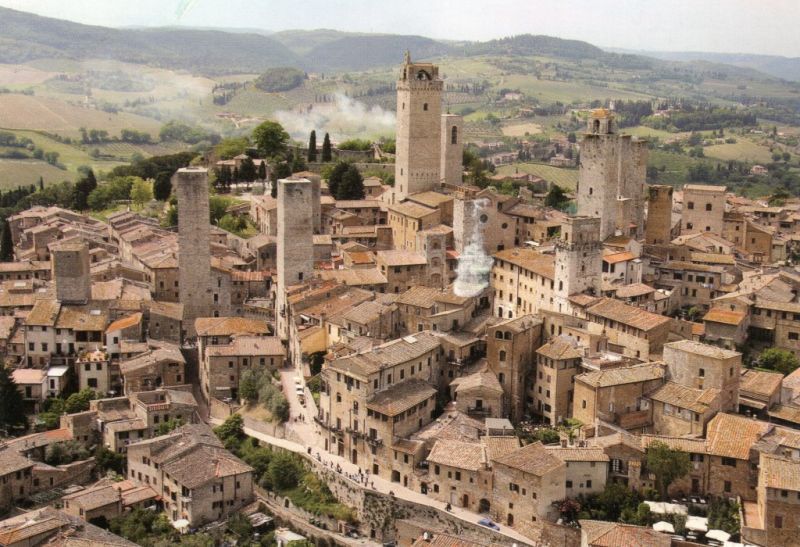SAN GIMIGNANO: A TOWN OF FINE TOWERS

San Gimignano is a wonderful medieval village, surrounded by ancient
walls, immersed in the Sienese countryside. It is a town of high artistic
interest. Founded in Etruscan times, it developed during the Middle Ages. The
village stands on a hill overlooking the vineyards and olive groves of the
marvelous Val d ’Elsa.
The medieval village of San Gimignano has remained almost completely
intact in its 13-14th century appearance. It is one of the best examples of
urban organization in the communal age in Europe. With its towers, its historic
buildings, ancient churches and craft shops.
 San Gimignano in 1990 was declared a World Heritage Site by UNESCO. It
is famous throughout the world for its fourteen towers and for the countless
architectural works, including the fantastic Romanesque Cathedral. Museums,
churches, theaters and palaces are scattered throughout the village, subjected
entirely to monumental restrictions since 1929.
San Gimignano in 1990 was declared a World Heritage Site by UNESCO. It
is famous throughout the world for its fourteen towers and for the countless
architectural works, including the fantastic Romanesque Cathedral. Museums,
churches, theaters and palaces are scattered throughout the village, subjected
entirely to monumental restrictions since 1929.The city was built on a hill 300m high, from the evidences found it was already inhabited in Etruscan and Hellenistic times. Probably the hill was chosen for its dominant position that allowed to keep the Val d’Elsa under control. Probably the village was so called around the 10th century AD in honor of San Gimignano, bishop of Modena who lived in the fourteenth century. It is said that he saved her from the assault of the barbarians by appearing on the city walls.
San Gimignano experienced its most flourishing period in the Middle
Ages. The village was located on the Via Francigena, one of the main
communication routes of the time. It became a point of reference for traders,
wayfarers and pilgrims who came to Rome.
 Around 1150,
despite the opening of a new Francigena route, San Gimignano continued to be an
emerging center. It had a territorial expansion policy and a significant growth
in commercial activities. Despite the infighting between the Guelphs and the Ghibellines, the thirteenth
century was the century of greatest economic development for San Gimignano,
thanks to the trade in local agricultural products such as saffron and wines.
The city was greatly enriched and numerous public works were also completed. The solid economy allowed the creation of an urban aristocratic class, which
expressed its political and social supremacy in the construction of the towers:
in the fourteenth century it came to count 72 towers of which today only 14
remain. They
characterize the city profile. San
Gimignano was ruled by the Ghibellines until 1255, the year in which it passed
into the hands of the Guelphs, who destroyed the original walls. By winning the
famous Battle of Montaperti in 1260 the Ghibellines regained possession of the
city, rebuilding and enlarging its walls.
Around 1150,
despite the opening of a new Francigena route, San Gimignano continued to be an
emerging center. It had a territorial expansion policy and a significant growth
in commercial activities. Despite the infighting between the Guelphs and the Ghibellines, the thirteenth
century was the century of greatest economic development for San Gimignano,
thanks to the trade in local agricultural products such as saffron and wines.
The city was greatly enriched and numerous public works were also completed. The solid economy allowed the creation of an urban aristocratic class, which
expressed its political and social supremacy in the construction of the towers:
in the fourteenth century it came to count 72 towers of which today only 14
remain. They
characterize the city profile. San
Gimignano was ruled by the Ghibellines until 1255, the year in which it passed
into the hands of the Guelphs, who destroyed the original walls. By winning the
famous Battle of Montaperti in 1260 the Ghibellines regained possession of the
city, rebuilding and enlarging its walls.
The historic
center of San Gimignano offers medieval masterpieces including the famous
towers that still stand out on its panorama and which have earned it the
definition of "Manhattan of the Middle Ages". Of the 72 original
towers only 14 have remained. The oldest is Torre Rognosa, 51 meters high, and
the highest is Torre Grossa of 54 m. Torre grossa, dates back to the 14th century and it is possible to visit it to
enjoy the spectacle from above the whole town and the surrounding hill
landscape.
BIBLIOGRAPHY:
-
Centre, UNESCO World Heritage. “Historic Centre of San Gimignano.” UNESCO World Heritage Centre, https://whc.unesco.org/en/list/550/.
- Encyclopedia Britannica. (2019). San Gimignano | Italy. [online] Available at: https://www.britannica.com/place/San-Gimignano
- Visitworldheritage.com. (2019). Historic Centre of San Gimignano, Italy | World Heritage Journeys of Europe.



Very interesting article! I love the images. It's really cool to see the patterns in the vineyards outside of the city.
ReplyDeleteI really like reading about the city is built into the countryside with ancient walls. This seems like a really beautiful city that I want to visit someday. I like the images you included, they really capture the beauty of the city. Great blog full of information I did not know!
ReplyDeleteThis city seems like it had a very hilly landscape. I wonder how this impacted the routes of people in the streets, especially if they were hauling goods. It makes me wonder if people who had trouble getting around like older or injured citizens were able to thrive here as much as they would if the landscape was flat.
ReplyDeleteThis comment has been removed by the author.
ReplyDeleteI also appreciate the beautiful landscape this town offers. The rolling hills are perfect for grape vines and olives. The geography looks similar to a small town I visited in Italy during my study abroad!
ReplyDelete